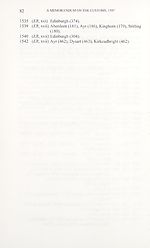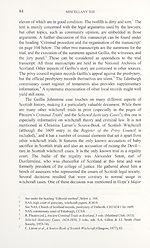Series 5 > Miscellany [of the Scottish History Society] XIII
(98) Page 83 - Trial of Geillis Johnstone for witchcraft, 1614
Download files
Complete book:
Individual page:
Thumbnail gallery: Grid view | List view

THE TRIAL OF GEILLIS JOHNSTONE
FOR WITCHCRAFT, 1614
edited by Michael B. Wasser and Louise A. Yeoman
INTRODUCTION
On 2 March 1614, the inhabitants of Edinburgh witnessed the end of a
protracted struggle: Geillis Johnstone was finally tried for witchcraft. The
story recorded by the trial was one of a conflict being waged at three
levels. The first was at the level of personal and community interaction,
as, over a span of years, Geillis slowly acquired a reputation as a witch,
and a consulter of witches. Her reputation bore fruit in the spring of
1609, when her enemies made a formal accusation resulting in a trial
before the presbytery of Dalkeith. This initial trial signalled the second
level of conflict: the unremitting war of the presbyterian kirk against the
machinations of the Devil. Geillis was convicted of witchcraft at this
time, but the story did not end there. There was a third level still to go -
that of the secular legal system, and its struggle for supremacy and the
rule of law. Geillis appealed her conviction to the privy council, arguing
that a presbytery did not have jurisdiction to try her for witchcraft. On 20
July 1609, the privy council agreed with her, quashed the proceedings of
the presbytery, and ruled that a valid trial could be held only by the
justice general, or the lord of the regality of Dunfermline.1 It took five
years, but Geillis was eventually tried before the regality court of
Dunfermline, only to be acquitted on all the charges.
There are three manuscripts included here. The main one is a draft
transcript of the proceedings of the 1614 trial, which was preserved in the
records of the high court of justiciary.2 It consists of twelve folio pages.
' Register of the Privy Council of Scotland {RPC), viii, 328-9. See also RPC, xiv, 612, for
the personal account of Sir Thomas Hamilton, then king’s advocate, and later earl of
Haddington. These events are also referred to in the main manuscript.
2 National Archives of Scotland (NAS), high court of justiciary, court books, old series,
regality of Dunfermline, JC1/38.
FOR WITCHCRAFT, 1614
edited by Michael B. Wasser and Louise A. Yeoman
INTRODUCTION
On 2 March 1614, the inhabitants of Edinburgh witnessed the end of a
protracted struggle: Geillis Johnstone was finally tried for witchcraft. The
story recorded by the trial was one of a conflict being waged at three
levels. The first was at the level of personal and community interaction,
as, over a span of years, Geillis slowly acquired a reputation as a witch,
and a consulter of witches. Her reputation bore fruit in the spring of
1609, when her enemies made a formal accusation resulting in a trial
before the presbytery of Dalkeith. This initial trial signalled the second
level of conflict: the unremitting war of the presbyterian kirk against the
machinations of the Devil. Geillis was convicted of witchcraft at this
time, but the story did not end there. There was a third level still to go -
that of the secular legal system, and its struggle for supremacy and the
rule of law. Geillis appealed her conviction to the privy council, arguing
that a presbytery did not have jurisdiction to try her for witchcraft. On 20
July 1609, the privy council agreed with her, quashed the proceedings of
the presbytery, and ruled that a valid trial could be held only by the
justice general, or the lord of the regality of Dunfermline.1 It took five
years, but Geillis was eventually tried before the regality court of
Dunfermline, only to be acquitted on all the charges.
There are three manuscripts included here. The main one is a draft
transcript of the proceedings of the 1614 trial, which was preserved in the
records of the high court of justiciary.2 It consists of twelve folio pages.
' Register of the Privy Council of Scotland {RPC), viii, 328-9. See also RPC, xiv, 612, for
the personal account of Sir Thomas Hamilton, then king’s advocate, and later earl of
Haddington. These events are also referred to in the main manuscript.
2 National Archives of Scotland (NAS), high court of justiciary, court books, old series,
regality of Dunfermline, JC1/38.
Set display mode to:
![]() Universal Viewer |
Universal Viewer | ![]() Mirador |
Large image | Transcription
Mirador |
Large image | Transcription
Images and transcriptions on this page, including medium image downloads, may be used under the Creative Commons Attribution 4.0 International Licence unless otherwise stated. ![]()
| Scottish History Society volumes > Series 5 > Miscellany [of the Scottish History Society] XIII > (98) Page 83 - Trial of Geillis Johnstone for witchcraft, 1614 |
|---|
| Permanent URL | https://digital.nls.uk/127314705 |
|---|---|
| Description | Edited by Michael B. Wasser and Louise A. Yeoman. |
| Description | Over 180 volumes, published by the Scottish History Society, containing original sources on Scotland's history and people. With a wide range of subjects, the books collectively cover all periods from the 12th to 20th centuries, and reflect changing trends in Scottish history. Sources are accompanied by scholarly interpretation, references and bibliographies. Volumes are usually published annually, and more digitised volumes will be added as they become available. |
|---|


